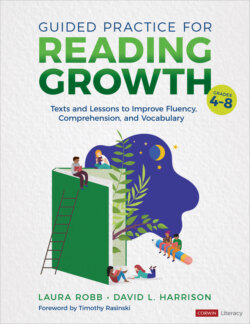Читать книгу Guided Practice for Reading Growth, Grades 4-8 - Laura Robb - Страница 9
На сайте Литреса книга снята с продажи.
ОглавлениеForeword
Recent assessments of eighth grade reading achievement in the United States have not been encouraging. In the most recent National Assessment of Educational Progress (The Nation’s Report Card, 2019) report, eighth grade reading achievement was largely the same as it was over 20 years ago. In 1998, the percentage of eight graders reading below a basic level was 27%. In 2019, the percentage reading below basic was exactly the same—27%. The percentage reading at proficient or advanced actually declined from 1998!
What’s going on? We’ve been told that we need to rely more on the science of reading in developing curriculum and delivering instruction. In the middle grades, the science of reading suggests that a focus on vocabulary, fluency, and comprehension are appropriate. I agree fully. Middle grade students cannot comprehend a text well if they don’t understand the words in the text; they will experience difficulty in comprehension if they are not fluent (effortless and expressive) in their reading; and certainly, they cannot comprehend what they read if they are not actively involved in making meaning as they read.
But this understanding of the science of reading has been known since the report of the National Reading Panel in 2000. Certainly, we should have expected some improvement over the next 19 years as schools and reading programs embraced the science of reading. And yet, we have barely even budged the needle.
While acknowledging the importance of science in teaching reading, we need to also recognize that teaching in general, and the teaching of reading, in particular, is also an art (Rasinski, 2019). Teachers need to be artists as well as scientists. We need to find ways of delivering scientifically based instruction in artful, engaging, and authentic ways.
Enter Laura Robb and David Harrison. Both are good friends of mine. More importantly, both are passionate literacy educators in their own ways. Laura is first and foremost a middle school teacher. She is also a scholar-author of several books on teaching reading in the middle grades. David’s primary passion is as a poet (pardon the alliteration)—an award-winning poet. But he has also written professionally on the value of using poetic texts in the literacy curriculum. An interesting combination, wouldn’t you say? A teacher who is also a scholarly author, and a poet who wants to improve literacy instruction in the classroom Yet, it is often combinations like these that can lead to remarkable results.
In their new book, Laura and David provide you with actionable and artful lessons for use in your classroom for what we now call close reading. What I truly love about the lessons is that they can be used as models for developing your own lessons. David actually provides with the relatively short text (canvas) for each lesson, and Laura provides you with the instructional brush strokes for helping students take a deep dive into vocabulary, fluency, comprehension, and writing. The appendix provides you with great resources for developing your own masterpiece lessons.
What excites me even more about this book is its emphasis on reading fluency through practice and performance (Part 3). My own research (Rasinski, 2010), as well the research of others (Rasinski, Reutzel, Chard, & Linan-Thompson, 2011), indicates that fluency is a critical instructional goal of reading through the middle grades and beyond (Paige, Rasinski, & Magpuri-Lavell, 2012, 2014; Rasinski et al., 2005; Rasinski, Rikli, & Johnston, 2009). And yet, it often suffers from benign neglect in many classrooms (Rasinski, 2012). As a result, we have many middle and secondary students who struggle in overall reading achievement in the middle and secondary grades (recall the 2019 NAEP results for Grade 8). Robb and Harrison provide you with instructional guidelines for providing students with opportunities to practice (rehearse) and perform, with expression and meaning, the wonderfully aesthetic texts that David Harrison has written.
There is so much to like about what Laura and David have written. After you read it, and try it out with your students, I hope you will agree that this book will help you understand better that the best reading instruction in the middle grades is both a science and an art.
Timothy Rasinski, PhD
Professor of Literacy Education
Rebecca Tolle and Burton W. Gorman Chair in Educational Leadership
Kent State University
References
NAEP. (2019). NAEP Report Card: Reading National. The Nation’s Report Card. Retrieved from https://www.nationsreportcard.gov/reading/nation/achievement/?grade=8
Paige, D. D., Rasinski, T. V., & Magpuri-Lavell, T. (2012). Is fluent, expressive reading important for high school readers? Journal of Adolescent & Adult Literacy, 56(1), 67–76.
Paige, D. D., Rasinski, T. V., Magpuri-Lavell, T., & Smith, G. (2014). Interpreting the relationships among prosody, automaticity, accuracy and silent reading comprehension in secondary students. Journal of Literacy Research, 46(2), 123−156.
Rasinski, T. (2010). The fluent reader: Oral and silent reading strategies for building word recognition, fluency, and comprehension (2nd ed.). New York, NY: Scholastic.
Rasinski, T. (2012). Why reading fluency should be hot. The Reading Teacher, 65, 516−522.
Rasinski, T. (2019). Teaching reading is an art as well as a science. The Robb Review. Retrieved from https://therobbreviewblog.com/uncategorized/teaching-reading-is-an-art-as-well-as-a-science/
Rasinski, T., Padak, N., McKeon, C., Krug-Wilfong, L., Friedauer, J., & Heim, P. (2005). Is reading fluency a key for successful high school reading? Journal of Adolescent and Adult Literacy, 49, 22−27.
Rasinski, T. V., Reutzel, C. R., Chard, D., & Linan-Thompson, S. (2011). Reading fluency. In M. L. Kamil, P. D. Pearson, B. Moje, & P. Afflerbach (Eds.), Handbook of reading research, volume IV (pp. 286−319). New York, NY: Routledge.
Rasinski, T., Rikli, A., & Johnston, S. (2009). Reading fluency: More than automaticity? More than a concern for the primary grades? Literacy Research and Instruction, 48, 350−361.
